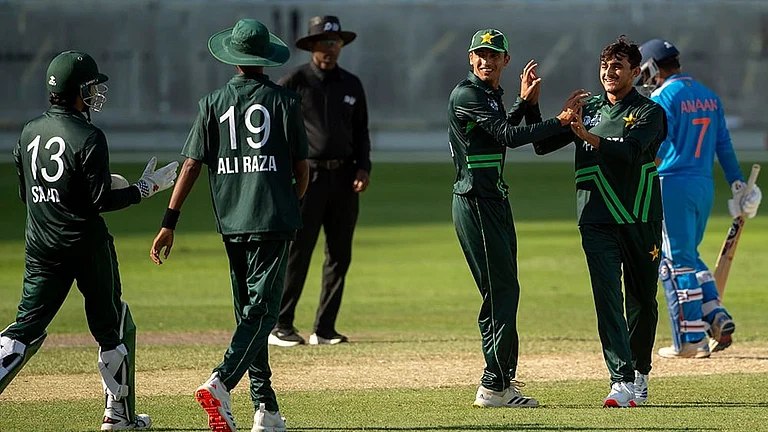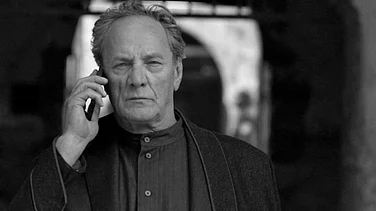The 8-ft-by-4-ft depiction of ‘Vishwaroopam’ literally dwarfs Prince Thonnakkal’s slight frame. It is the only painting this master has painted out of the 113 frames of murals through which the Mahabharata unfolds in bright colours and intricate patterns. He left it to his 35 woman students to bring the rest of the epic to life.
“It is only appropriate that Prince Sir came up with the Vishwaroopam,” says Meena Kumari, a retired postal employee and former Kerala state footballer from Thiruvananthapuram, who has been a student of Thonnakkal since 2000. “Just as the god’s cosmic form inspired Arjuna on the battlefield, our master has been the inspiration behind this massive project. We owe the revival of mural art in south India to him.”
To Thonnakkal, 48, goes the credit of bringing the mural, essentially a temple art that adorns the walls of Kerala’s temples, out into the open by the bold use of acrylic colours. The original art involves the use of vegetable dyes painted on cured walls, but that calls for a lot of patience and confines the art within four walls. Thonnakkal himself learnt it the traditional way from the legendary Mammiyur Krishnankutty Nair, who had revived the murals at the Guruvayur temple after they were destroyed in a fire.

Though he completed many murals for Kerala’s temples, Thonnakkal felt that for the art to gain greater exposure and popularity, he needed another medium to depict the murals. So he chose acrylic paint for its ease of availability, durability and portability. Also a spray of varnish over the painting would preserve it from the elements. “I could roll up the Vishwaroopam in Kerala, transport it to Chennai and reframe it here. That is not possible with natural dyes. When you want to popularise the art, its ingredients should be easily accessible,” he says.
But the essential feature of murals—the colour scheme of predominant and bright ochre red and yellow along with green, blue and black—has been retained by Thonnakkal and his students. As “Mural Mahabharatham” unfolds frame after frame, the original colours get accentuated by the intricate detailing that fill up the spaces—whether it is the forest with its plants and trees or the palace with its decorative walls.
The characters, of course, are resplendent with ornamentation in dress and jewellery since Kerala’s mural art has always been about rich visual motifs. An underlying theme can be seen in the visuals, like Bhishma is shown only in silver ornaments throughout as he is associated with white standing for purity. “While Prince Sir drew the outline of the characters—they need to look similar in every frame—he left the ornamentation and colouring to the imagination of the students,” says Mythili Ganesh, a student from Chennai. “So during Karna’s birth, Drona’s archery test or even the birth of Ghatotkacha—even though they are by different artists—the peacock makes its presence as an ornamental bird.”
Asked why he chose woman artists from among his students for the project, Thonnakkal explains with a smile, “They are patient, have an eye for detail and more time on their hands. And they are less distracted. It took three years from 2014 since we had to choose the incidents from the Mahabharata and visualise them frame by frame. I had to travel between Thiruvananthapuram and Chennai to train the students after they chose (by lots) what to paint.” The experience of painting the Ramayana in 36 frames by 17 women in 2010 also came in handy.
“When the art scene is dominated by men, it is a healthy turn that Thonnakkal has used only woman artists for this project,” says Maniam Selvan, a leading artist from Chennai. “The work of many talented woman artists get confined to their homes, so it is heartening to see them get such a wide canvas and limelight. That 35 women have so rhythmically expressed an epic after devoting over three years is a further tribute to Thonnakkal’s dedication to mural art and the discipline he has inculcated to his students.”
Thonnakkal’s network of woman students was developed gradually over the years, just as a mural comes to life on the temple walls. “I first saw a small mural painting of his in a stationery shop and got his number from there,” recalls Meena Kumari. “He then visited me and agreed to teach me. I introduced some of my friends to him and the group expanded. Similarly, other students joined after seeing his murals in hotels and public places.”
Later, Thonnakkal’s following spread to other cities, especially Chennai, from where eight students joined the Mahabharata project. Though most of the 35 woman artists who are part of the Mahabharatha project are homemakers, there is also a former film star, a zoologist and a retired college principal.
The exhibition seems to slacken a bit only while interpreting the Bhagavad Gita in 39 frames devoted to its slokas. Barring a few frames, the portrayal of Krishna and Arjuna gets repetitive. But to retell the greatest epic in such vivid imagery is an achievement, and for that Thonnakkal and his students deserve kudos.
But what happens to ‘Mural Mahabharatham’ after it has run its course and made its stops across the cities? It needs a permanent home where it can be seen throughout the year. Thonnakkal is not sure. “We hope some large corporate house will provide a roof since all the 113 paintings have to be housed at a single place. Even getting sponsors for the ongoing tour has not been easy,” he shrugs.


























